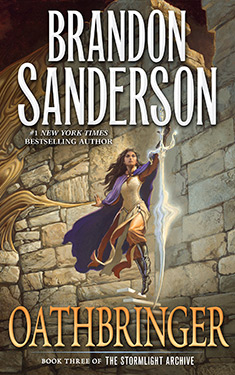Guest Post: Oathbringer Review
This guest post by Craig Hanks originally appeared at TheLegendariumPodcast.com and is reprinted here with permission. The Legendarium Podcast is a must for any Sanderson fan — these guys are the experts — and they cover many other epic fantasy staples including Lord of the Rings, Wheel of Time, and Shannara. You can subscribe to The Legendarium on iTunes.
A note on spoilers. In this review, I’m not going to spoil any major reveals. But a few general plot points are fair game here. So if you’re hoping to go into your reading of Oathbringer 100% fresh (not a bad call, since impeccable story structure and Roshar-shattering reveals are Sanderson hallmarks), turn back now. If you’re just looking for a little pre-game commentary, though, then read on.
“Your words are not that special, Brandon Sanderson.”
So said my wife after I congratulated myself on finishing one-third — 400 pages — of Oathbringer, the third of Sanderson’s mammoth Stormlight Archive series. Even for someone of my fantasy-oriented literary proclivities, this book is a monster. Ten-point type scrunched between barely-there margins, filling 1,250 pages? To the uninitiated, this appears as an act of extreme hubris. I assure you it is not.
It’s not hubris but deserved confidence that has driven Sanderson to write over a million words across three volumes of The Stormlight Archive so far. It’s the confidence of someone who is in full command of his prose and, more importantly, his worldbuilding. His words are great, but it’s his worlds that command attention. More on that in a bit; let’s talk Oathbringer specifically for a moment.
Listen to the spoiler-free review episode here:
The story still focuses on our three main characters: Kaladin, Shallan, and Dalinar. Where The Way of Kings revealed Kaladin’s back story and Words of Radiance did the same for Shallan, Oathbringer belongs to Dalinar. The title in this case refers not only to a book-within-the-book, as previously, but also to Dalinar’s mystical sword, or shardblade. Flashbacks show us Dalinar in his prime, wielding Oathbringer to devastating effect across the kingdom he is working to unite by force.
But the most impactful portions of the flashbacks are reserved for Dalinar’s relationship with his wife, memories of whom were apparently so painful that Dalinar had them magically excised from his mind. Learning what drove Dalinar to such drastic action makes for some of the most gut-wrenching scenes in Sanderson’s entire œuvre.
While the book focuses its flashbacks on Dalinar, fans of our other heroes need not worry; we spend plenty of time with both Kaladin and Shallan. Kaladin spends a good portion of Oathbringer learning that fulfilling his Windrunner oaths (“I will protect those who cannot protect themselves” / “I will protect even those I hate, so long as it is right”) requires actions that are not always easily justified.
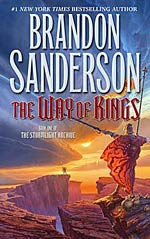 Meanwhile, Shallan is faced with the same dilemma as Vin, the heroine of the Mistborn trilogy: she must decide which of her personae is the true one. The more literal nature of Shallan’s journey toward self-understanding is a result of the magic systems peculiar to Roshar and Shallan in particular.
Meanwhile, Shallan is faced with the same dilemma as Vin, the heroine of the Mistborn trilogy: she must decide which of her personae is the true one. The more literal nature of Shallan’s journey toward self-understanding is a result of the magic systems peculiar to Roshar and Shallan in particular.
Oh, and praise the Stormfather, the love triangle between Shallan, Kaladin, and Dalinar’s son Adolin that started in book two is resolved here in a way that is at once unexpected, sensible, and satisfying. Which is for the best, since the series at large could easily have been bogged down by a bunch of unnecessary — and surely angsty — YA-style emotional handwringing.
Time must be taken here — because damned if plenty of time wasn’t taken in the first half of the book — to mention secondary and tertiary characters, of which there are legion. Fan favorites are either completely absent (Eshonai) or cruelly underused (Rock, Lopen), while others are unexpectedly given substantial page counts (Teft, Moash). Depending on your appetites, this will either be a boon or a curse. I’m still undecided.
Ultimately though, Oathbringer, while clocking in at an eye-popping 391,840 words, manages to be the tightest of the three Stormlight books in terms of character scope, especially in the last half. As with The Way of Kings, there comes a tipping point somewhere around halfway through the book where the setups beget payoffs, which come faster and faster until the final pages. If you’d asked me at page 500 whether Oathbringer is a page-turner, I’d have said no. By page 800, though, it was a firm yes.
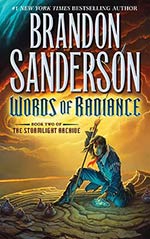 It’s not all roses, of course. As I’ve alluded to a few times already, this book is just plain long. While many high fantasy aficionados are ready and willing to dive into 1,000+ pages, such hefty word counts make The Stormlight Archives difficult to recommend to newcomers. If it’s true — as many Sanderson fans say — that this is his best series to date, then it’s a shame that it’s so difficult to recommend to anyone who isn’t yet on the Brandon train. Entry-level material this is not.
It’s not all roses, of course. As I’ve alluded to a few times already, this book is just plain long. While many high fantasy aficionados are ready and willing to dive into 1,000+ pages, such hefty word counts make The Stormlight Archives difficult to recommend to newcomers. If it’s true — as many Sanderson fans say — that this is his best series to date, then it’s a shame that it’s so difficult to recommend to anyone who isn’t yet on the Brandon train. Entry-level material this is not.
Another barrier to entry is Oathbringer’s dependency on Sanderson’s other work. To fully appreciate the characters and events of this book, it’s necessary not only to have read, but to remember fairly well several of his other “cosmere” books, especially Warbreaker, the Mistborn series, and Elantris.
Thankfully, these crossover moments are written in such a way that you won’t be slowed too much in your reading if you’re not familiar with these other books. But if you’re not up to speed with those stories, then you’ll likely be scratching your head at the end of Oathbringer, trying to figure out why certain characters and objects were so prominent. To a newcomer to Sanderson’s cosmere, this stuff will feel like so much bloat in an already massive book.
Back to those possibly-not-that-special words. There’s a tendency among Sanderson’s detractors, and even those who simply prefer other authors, to point to his prose style as lacking in some respect. The most common complaint I hear is something along the lines of, “It’s just so … utilitarian.”
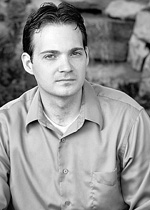 But this is precisely what I, and millions of others, enjoy. And Sanderson’s prosaic prowess is on full display in Oathbringer. “In the best prose,” as Arthur Clutton-Brock put it in his essay The Cardinal Virtue of Prose, “we are so led on as we read, that we do not stop to applaud the writer, nor do we stop to question him.” Indeed, rarely does Sanderson puncture the fourth wall of the narrative with a poetic flourish, drawing attention to himself rather than the story at hand. His discipline helps to make this a story in which you can — and should, and will — become blissfully lost.
But this is precisely what I, and millions of others, enjoy. And Sanderson’s prosaic prowess is on full display in Oathbringer. “In the best prose,” as Arthur Clutton-Brock put it in his essay The Cardinal Virtue of Prose, “we are so led on as we read, that we do not stop to applaud the writer, nor do we stop to question him.” Indeed, rarely does Sanderson puncture the fourth wall of the narrative with a poetic flourish, drawing attention to himself rather than the story at hand. His discipline helps to make this a story in which you can — and should, and will — become blissfully lost.
But why bother to get lost at all if the place you’re losing yourself isn’t worthwhile? Here we come to Sanderson’s true genius: creating compelling, instructive worlds and peopling them with compelling, instructive characters. And when it comes to his worlds, the rule is simple: worse is better. Sanderson’s M.O. seems to be to create the most vivid, dark, smelly, miserable, unstable locations he can think of, then set loose a cast of characters and see how they react. The now-classic example is that of Vin and Elend, Mistborn’s protagonists, wading hip-deep through never-ending volcanic ash toward the literal end of the world. “Bleak” doesn’t begin to cover it.
The world of The Stormlight Archive, like that of Mistborn, seems like a miserable place to be. A good portion of Sanderson’s magic comes in making you want to be there anyway, for as long as you can. Such is the case with Oathbringer. If my chief complaint with the book is its length, then next in line is that I can’t spend another thousand pages on Roshar.
“Your words are not that special, Brandon Sanderson.” That’s up for debate, I suppose, though I know where I’d come down. What’s not up for debate is that Sanderson’s worlds are indeed that special.
Recently Read Books in Brief
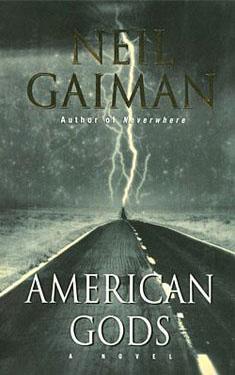 American Gods, by Neil Gaiman
American Gods, by Neil Gaiman
This is probably Gaiman’s most popular novel, and the 155 reads recorded from our members’ stats attests to that. I wish I could share their enthusiasm. While American Gods is certainly both competent and entertaining, I have enough problems with it that I simply don’t much care for it as a story. Gaiman’s prose style isn’t bad, though it is never great, and I would have liked something a little better for a story dealing with such high-minded ideas. But it is the ideas that are the problem, here. Gaiman has written about the survival of ancient, unworshipped gods before and since, especially in his Sandman series and in the later Anansi Boys. The big idea that he repeats in all these works is that gods are beings born out of the collective religious consciousness of a people, that they are phantasms which can exist only so long as they are worshipped, but who still possess what we would think of as godlike powers while they still live. This is hardly a dull idea, even if it is reheated Jungianism, and it’s not hard to see why it found such a large audience. Unfortunately, I simply cannot take Gaiman’s metaphysics seriously enough to enjoy the novel.
Even so, Gaiman imbues his story with some fine, human moments, and he even occasionally recalls his earlier skills as a horror writer. There’s a large section of the novel that takes place in an out-of-the-way town and which seems largely inconsequential to the story as a whole, despite a late attempt to tie it back into the main plot. The most entertaining part of the novel is that it makes you want to rummage through your Encyclopedia of Mythology to identify all the gods and demigods who appear (or you can use this cheatsheet, but where’s the fun in that?).
Not a bad read, but hard to take seriously, despite all its sound and fury. Might be worth reading as preparation for the upcoming HBO television adaptation.
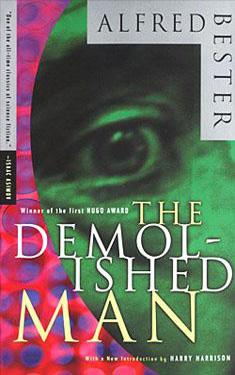 The Demolished Man, by Alfred Bester
The Demolished Man, by Alfred Bester
Ben Reich is a man troubled by dreams, living in a world of telepaths. Much as in Minority Report, crime is difficult to commit and easy to punish, and murder is all but impossible. The future sees humanity expanding to other planets, but still crippled by its faults and flaws. Bester does a magnificent job creating the world of 2301, and his prowess as world-builder is even better here than in his celebrated The Stars My Destination. Unfortunately, his skills as a crime-drama writer are not as good.
It’s not much of a spoiler say that Reich commits murder, because he does so very early in the novel. While there is some suspense in the first part of the book, that largely disappears once the murder is done. There is a long cat-and-mouse chase between Reich and the police, but frankly the reader spends most of his time waiting for the police to laboriously put together all the pieces he already knows, and then has to wait even longer to see if the unlikeable Reich ever gets caught and punished for his crime. The only suspense in the book concerns the identity of The Man With No Face, a dream image that haunts Reich’s dreams, but it’s not a very interesting mystery.
The Demolished Man is worth reading if only for some very intriguing prose interpretations of what a telepath conversation might be like, but not for the murder mystery which is at its core.
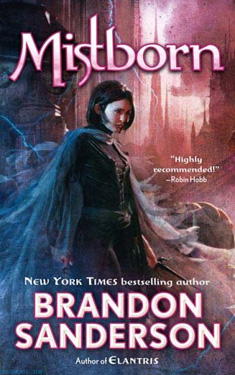 Mistborn, by Brandon Sanderson
Mistborn, by Brandon Sanderson
I became familiar with Sanderson after he was chosen to finish Robert Jordan’s Wheel of Time series, so I decided to give his most popular trilogy a try. Mistborn is set in something like a post-apocalyptic Middle Earth—it’s a fantasy world where the evil god/wizard/warrior has won the battle against the chosen hero and remade the world in his own image. This is a magnificent idea, and Sanderson has a lot of fun with it in the first book of the trilogy. The resistance fighters are something like real-world revolutionaries, and are very much the underdogs. The group of heroes in here isn’t even the first to have attempted a revolution. This isn’t the kind of setup that would work apart from the larger body of genre fiction to play off of, but I expect it will be especially appreciated by those who have read fantasy for years.
Still, this isn’t a great series. Sanderson is a good writer, but I think he has a weakness when it comes to plotting. The first novel works as a whole, but the latter two are comparatively formless and sprawling. The trilogy ends in a very strange way, with an unfortunately literal deus ex machina. However, the alchemically-based system of magic is actually very detailed and precise in its functioning, something rare in fantasy literature, and much appreciated.
The first novel is decent, but it will make you want to read the follow-ups that fail to live up to the original.
It’s Always Darkest Just Before Midnight
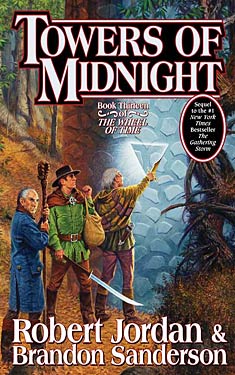 Robert Jordan’s Wheel of Time series is a divisive body of work even among his long-time readers. Starting off as a close imitation of Tolkien’s Lord of the Rings, by the second book Jordan had gained enough confidence in his own storytelling abilities to make his world unique. The first four novels follow the three young men who are destined to be the center of many important events leading to the Last Battle against the Dark One, a godlike being trying to escape his prison, and the novels are very action-oriented without sacrificing too much nuance of character and philosophy. Unfortunately the fifth novel, The Fires of Heaven, saw a shift from characters and action to politics and battle maneuvers. This was partially due to the fact that the three protagonists were gaining positions of political influence and had begun leading large armies, but Jordan failed to balance this new focus with the old, eventually sacrificing everything that originally made the series interesting in favor of texts that read like the dullest of history books. Jordan’s penchant for free indirect style was good for the early, limited cast, but once the narrative expanded to encompass the entire known world it suddenly became both impractical and debilitating. By the eighth book the series had nearly ground to a halt, each novel consisting mainly of political and military maneuvering, usually with some major battle or event slipped into the final chapter to keep the fans happy.
Robert Jordan’s Wheel of Time series is a divisive body of work even among his long-time readers. Starting off as a close imitation of Tolkien’s Lord of the Rings, by the second book Jordan had gained enough confidence in his own storytelling abilities to make his world unique. The first four novels follow the three young men who are destined to be the center of many important events leading to the Last Battle against the Dark One, a godlike being trying to escape his prison, and the novels are very action-oriented without sacrificing too much nuance of character and philosophy. Unfortunately the fifth novel, The Fires of Heaven, saw a shift from characters and action to politics and battle maneuvers. This was partially due to the fact that the three protagonists were gaining positions of political influence and had begun leading large armies, but Jordan failed to balance this new focus with the old, eventually sacrificing everything that originally made the series interesting in favor of texts that read like the dullest of history books. Jordan’s penchant for free indirect style was good for the early, limited cast, but once the narrative expanded to encompass the entire known world it suddenly became both impractical and debilitating. By the eighth book the series had nearly ground to a halt, each novel consisting mainly of political and military maneuvering, usually with some major battle or event slipped into the final chapter to keep the fans happy.
With Jordan’s death in 2007, many fans suspected that they would never get to see how his story ended. Despite slamming on the narrative brakes through so many novels, the occasional battle or character portrait—the chapter "Honey in the Tea" in Knife of Dreams is a great example of the latter—were proof that Jordan could still write thrilling stories if he put his mind to it. However, his increasingly debilitating sickness coupled with his longstanding promise to destroy all of his notes should he die before completing the series threatened to create a legion of frustrated fans. Thankfully, Jordan rescinded his note-destroying policy and picked fantasy novelist Brandon Sanderson to complete the series after his death. While both Jordan and Sanderson originally intended to complete the series in just one more book, it became obvious to Sanderson that it would take a trilogy to untangle all of Jordan’s knots. Towers of Midnight is the second of Sanderson’s trilogy, after the more politically heavy The Gathering Storm, and it is truly a return to the action- and character-centric approach of the early novels.
Despite my earlier griping about Jordan’s political and military obsessions, they do begin to pay off in Towers of Midnight. That continent-spanning web he had spun starts to come crashing down like a meteor, and we finally get to see just how big the Last Battle is going to be. It still feels like Sanderson is being forced to juggle more items than he’s comfortable with, but he keeps them all in the air just long enough for the big finale, which will be hitting readers in force with the upcoming A Memory of Light.
It is especially good to see so many promised character arcs pay off. Rand returns to sanity, Perrin finds a balance with his wolf nature, Mat faces the monsters of his past, Egwene establishes her rule, a royal family is reunited, an old character is rescued from a torturous fate, a possible future is glimpsed; it’s like a checklist of all the things we’ve been wanting to see for over a decade, but which were put aside in favor of narrative machinations of questionable worth. No doubt Jordan would have given us the same things had he time, but Sanderson brings a great energy to the proceedings, which is surely why Jordan chose him as a replacement. With so many character arcs cleared away, Sanderson sets himself up for a Last Battle that will have plenty of room for action without any frustration that one’s favorite character has been short-shrifted.
This would be a great place for old readers who abandoned the series to jump back on. I only skimmed Sanderson’s previous novel (The Gathering Storm being saturated with politics as it was), but I couldn’t put this one down. Still, this is hardly the best recommendation for convincing non-fans to start on The Wheel of Time. Depending on how well A Memory of Light wraps up the series, one wonders if it will be worth the eventual frustration to start it. Jordan created a world with a lot of promise, and we’re about to find out how much of that promise will be kept.



















 Full Details
Full Details
